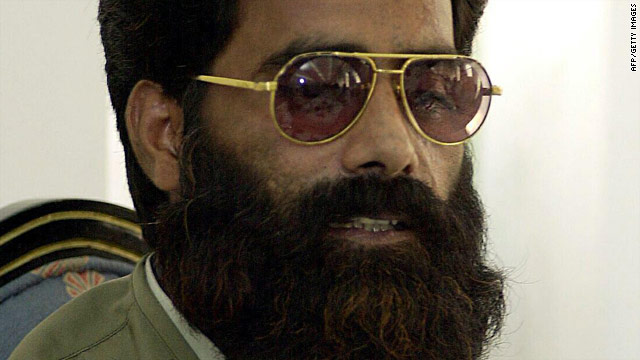Ilyas Kashmiri: Most dangerous man on Earth?
November 10, 2010 4:49 p.m. EST
(CNN) -- He has one eye, a thick beard streaked with henna and has lost a finger. He wears thick aviator-style dark glasses. At least we think so. There are very few photographs of 40-something Ilyas Kashmiri. But to counter-terrorism officials on three continents, he is one of the most dangerous men in the world.
Kashmiri is a veteran jihadist who in his early years fought the Indians in the disputed territory of Kashmir and the Russians in Afghanistan, which is where he lost his eye. He famously escaped from an Indian jail and then fought with a unit of Pakistan's special forces.
And he is ruthless. Ten years ago, Indian troops carried out a raid into Pakistani Kashmir. Pakistani officials said 14 civilians including several children were slaughtered.
The next day Kashmiri led a retaliatory raid. He and his fighters kidnapped and beheaded an Indian army officer -- his head later paraded in the bazaars of Pakistani Kashmir.
But then he fell out with his sponsors in the Pakistani military. At one point -- the date is disputed -- he was arrested in connection with an attempt to assassinate General Pervez Musharraf in 2003. For reasons unknown, Kashmiri was released a short time later.
And that was where the trouble really started, when a local jihadist went viral, moving his base of operations from Pakistani Kashmir to North Waziristan. As commander of "Brigade 313," part of Harakat-ul-Jihad-Islami (Movement for an Islamic Holy War), he formed a close relationshKashmiri's number one enemy is still India. His group was thought responsible for the bombing of a bakery popular with foreigners in Pune in 2009. But there is plenty of evidence he has ambitions beyond South Asia.
David Coleman Headley, the US citizen who confessed to helping scout targets for the Mumbai attack in November 2008, said after his arrest that he had twice met Kashmiri.
During questioning by India's National Intelligence Agency -- which was given access to him in Chicago in June -- Headley said he'd been taken to Pakistan's tribal territories to meet Kashmiri early in 2009.
A copy of the interrogation obtained by CNN reveals that Kashmiri sent Headley on another trip to survey targets in India -- one place he said he video-taped was the Pune bakery.
He also said Kashmiri had encouraged him to attack the offices of the Danish newspaper that published cartoons of the Prophet Mohammed. According to the indictment of Headley, Kashmiri told him he could "provide manpower, weaponry and funding for the Denmark operations." Headley says Kashmiri gave him $1,500 and told him to "concentrate on the Denmark attack at the earliest."
Headley traveled to England, Sweden and Denmark to refine his plans, before being arrested at Chicago airport in October 2009 as he planned to leave for Pakistan. In a plea deal this year, Headley confessed to his involvement in both the Mumbai and Danish plots.
Now intelligence sources on both sides of the Atlantic believe Kashmiri is trying to get teams into Europe that would launch coordinated Mumbai-style attacks in several cities. The British Home Secretary, Theresa May, said last week that police were receiving special training to handle such an attack.
In a rare interview with Asia Times Online last year, Kashmiri boasted of those plans. The newspaper's Islamabad reporter, Syed Saleem Shahzad, says he was taken to a secret location in North Waziristan, in October 2009. Kashmiri apparently wanted to use the occasion to refute claims that he'd been killed in a drone strike near the town of Mir Ali the previous month.
Shahzad describes meeting a tall, well-built man with a firm handshake. He asked him whether the world could expect more "Mumbai-style" attacks. "That was nothing compared to what has already been planned for the future," Ilyas replied.
European intelligence officials are now anxious "the future" may be imminent, with al Qaeda looking to use people with Western passports in attacks -- Europeans and North Africans, for example.
There are plenty of foreign fighters in the Pakistani tribal territories -- as many as 10,000 according to a Pakistani military commander. One of them, Ahmed Sidiqi, was detained in Kabul last July and interrogated by US forces at the Bagram Airfield. According to European counter-terrorism sources, Sidiqi said he had met Kashmiri, though there is no confirmation that he did.
Another man alleged to have sought out Kashmiri is Chicago taxi driver Raja Lahrasib Khan, who traveled to Pakistan in 2008 and 2009. He was arrested this year in the United States and charged with attempting to provide support to al Qaeda.
Court documents say Khan met Kashmiri, who had told him that he "wanted to train operatives to conduct attacks in the United States." The documents include a conversation Khan is alleged to have had with an unidentified conspirator about Kashmiri's relationship with Osama bin Laden.
UC1: OK, Osama bin Laden's giving orders.
KHAN: Yeah.
UC1: Does he give orders to Kashmiri? Did Kashmiri...
KHAN: Just, yeah, to Kashmiri, then Kashmiri give the order to mujahideen...
Khan has pled not guilty.
Intelligence officials say that besides being an experienced operator, Kashmiri has also managed to navigate the often perilous waters of jihadist rivalries, attracting members of other Pakistani groups to his "313 Brigade" and retaining a measure of autonomy despite pledging allegiance to al Qaeda.
That's probably in part because of his operational prowess. If Osama bin Laden is al Qaeda's "spiritual" leader and Egyptian cleric Ayman al Zawahiri its philosopher, Kashmiri is the organization's military brain.
As one U.S. official put it recently, Kashmiri is "the key ingredient in the bad stew of senior terrorists who are planning operations in the region and beyond."ip with al Qaeda in the wild frontier territory of Pakistan.


No comments:
Post a Comment